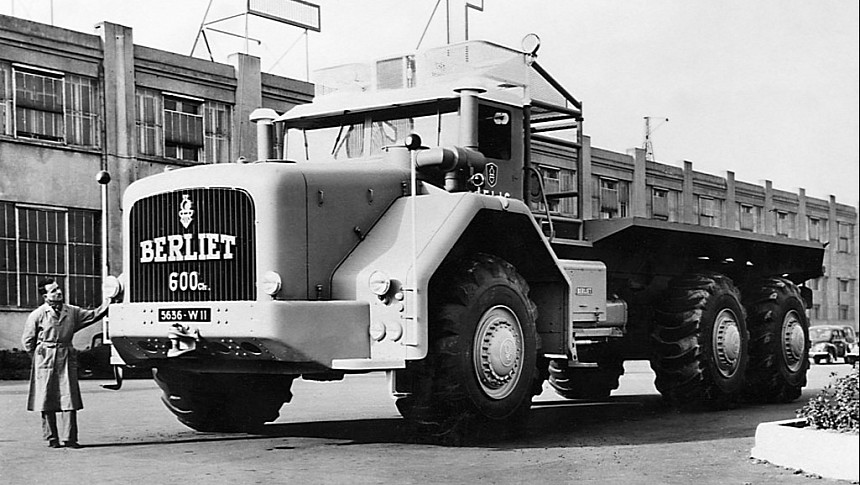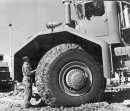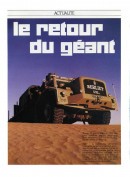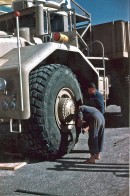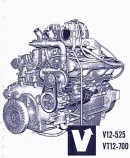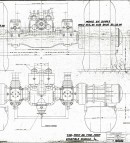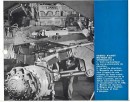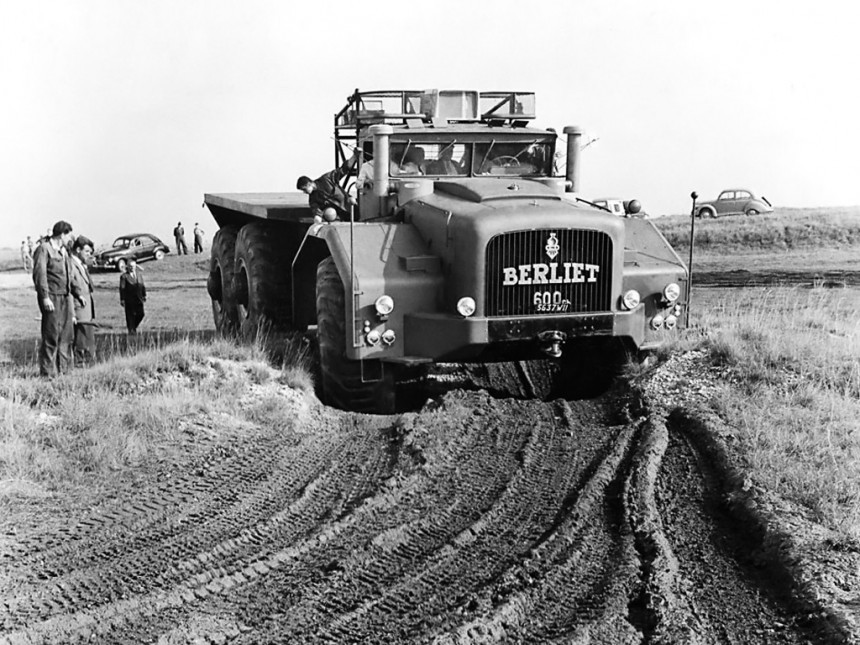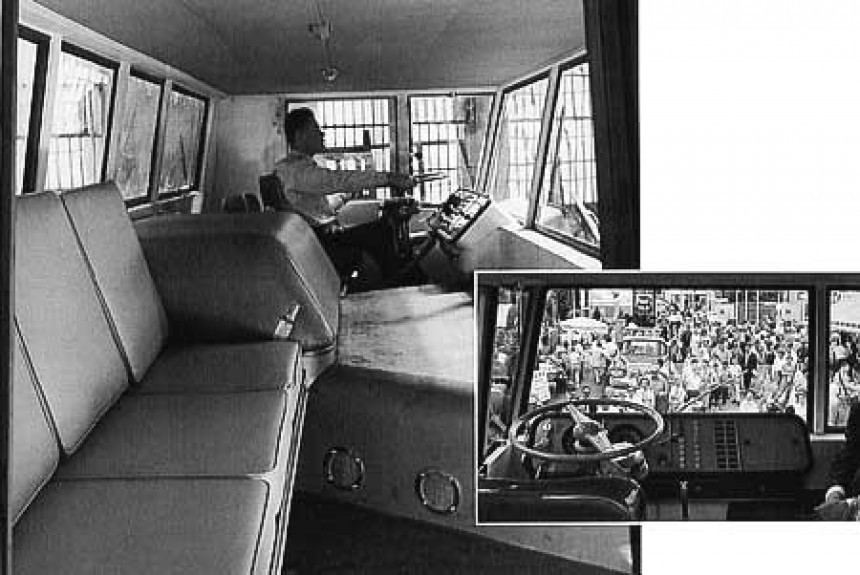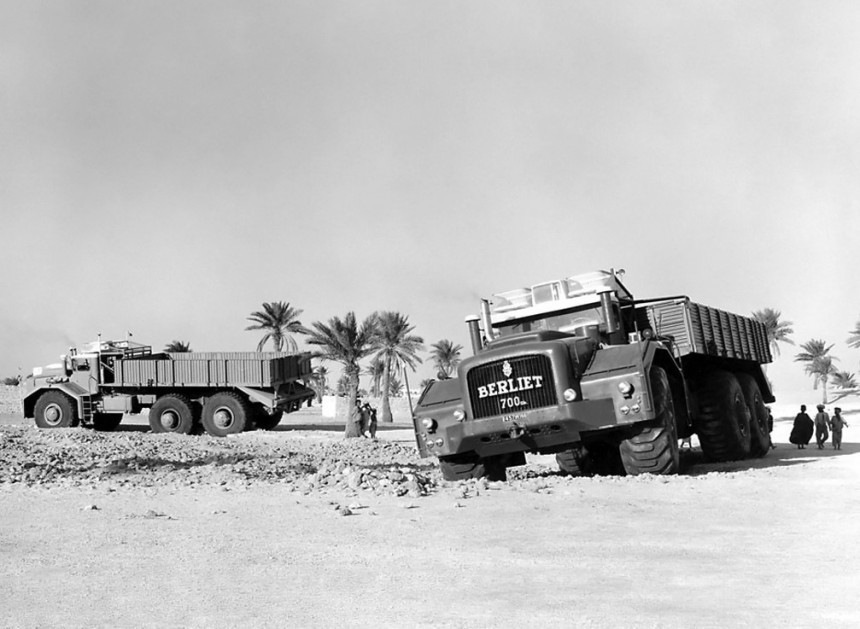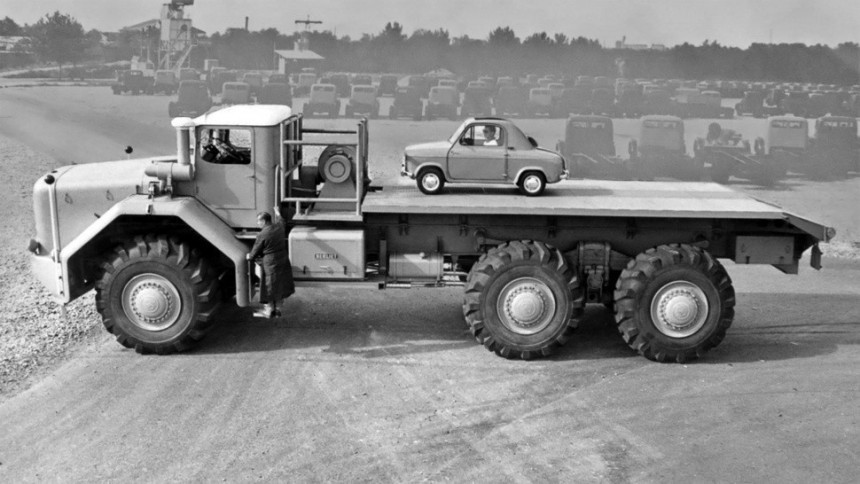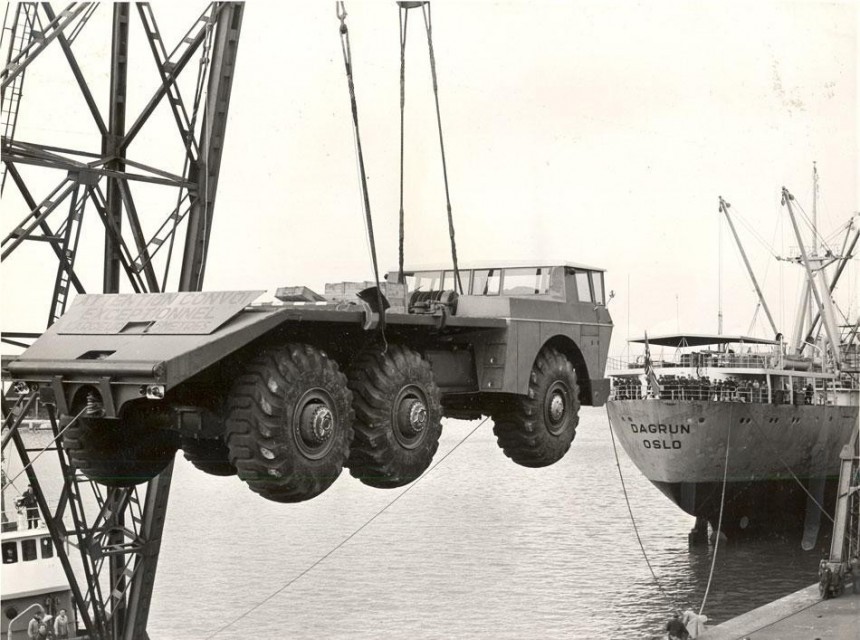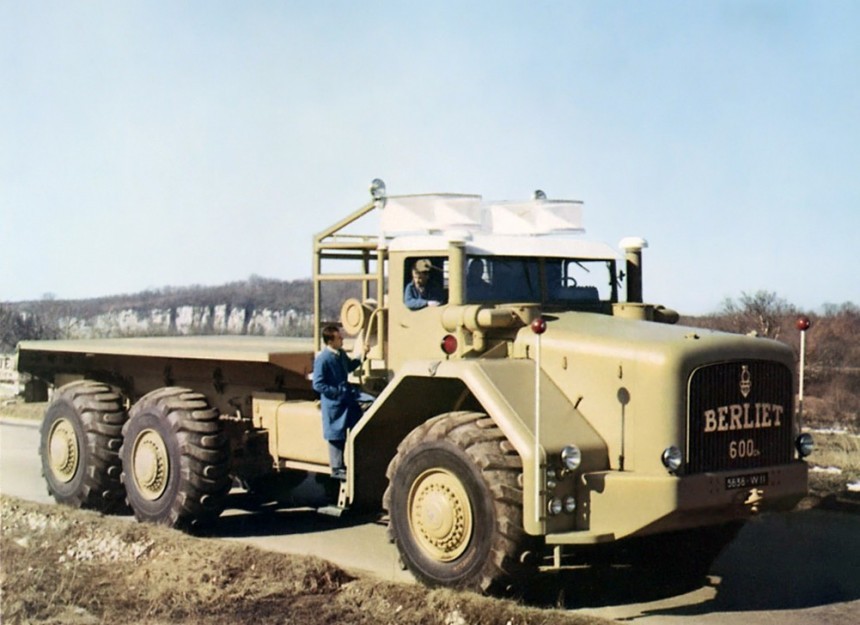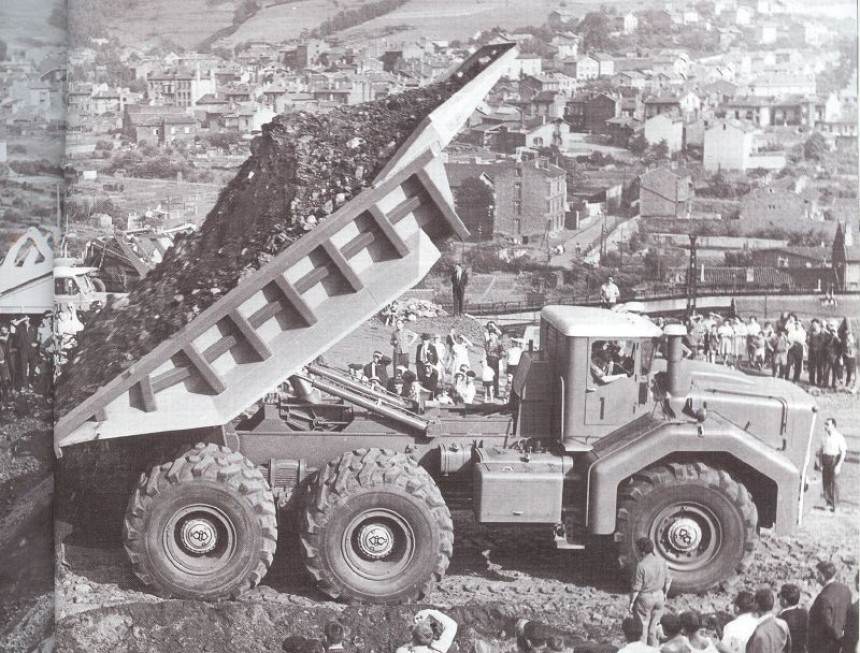In the final years of the 1950s, oil was struck in the south of present-day Algeria, in the blazing hell of the Sahara Desert. to begin exploting the oilfields, a fernch company built the biggest truck in the world at that time - the 50-tons Berliet T100, with a payload of 50 tons. Four trucks were assembled, and only one survives today.
In the wake of the Second World War, the reshaped geopolitics of the planet changed dramatically, more or less (actually more) shared between the new two superpowers, the United States and the Soviet Union. Empires were falling apart; colonial powers were hammered by wars for independence fought by nations far and wide. Traditional imperialism was replaced by its newest form – the globalized economy. The race for resources was more intense than ever before.
By the middle of the 20th century, it had become clear to everyone that oil was a critical natural resource, and vast efforts were spent to find new fields of the precious fossil. From the frozen tundra of the North to the rainforests of the Amazon, the Black Gold Rush was in full swing. In the mid-fifties, oil was struck in the Sahara Desert in Algeria.
Back then, the vast territory was a French colony, and the European republic wasn’t about to relinquish independence to the African nation just like that. France was more akin to being the exploiter, and the short years of German occupation during the Second World War didn’t instill a sudden sense of righteousness in the pockets of the French politicians.
Democracy aside, the Algerian oil was only as good as it could be extracted, refined, and sold, and that implied one crucial thing: getting to the oil field first. However, one particularity of the sandy desert of the Sahara is that it doesn’t have a stable geography; the landscape constantly shifts, and the dunes behave like gigantic waves that make building permanent transport infrastructure nearly impossible.
The vehicles of the period were catastrophically inept at braving the vastness of the Sahara and carrying the vital rigging equipment for digging wells. Building roads was expensive, impractical, and time-consuming. Oilmen retorted to camel caravans, but the animals weren’t the best solution for transporting heavy equipment. Something had to be done.
Believe it or not, back in the fifties, one of the largest truck manufacturers in the world was a French company by the name of Berliet. The heavy equipment constructor proposed various vehicles for the oil business, but none proved adequate in the hell of internal combustion hell that geographers refer to as the Sahara.
The constructor had to develop an entirely new platform, which they did in big style. Really big style: the Berliet T100 was the biggest truck in the world when it came out in 1958—fifty tons of steel and rubber, with a payload equal to its own weight. At full capacity, the 100-ton behemoth was more than able to sail the dunes of the Northern African sands.
The titanic truck measured 13.3 meters (40 feet) in length, five meters (15 feet) across, and 4.4 meters (13.4 feet) at its highest point. The all-wheel drive six-wheeler sat on a wheelbase of 5.7 meters between the front and middle axle (17.4 feet), while the distance between the second and rear axle was a more modest 2.5 meters (7.6 feet).
At the time of its launch, it was the absolute ruler of the truck world – there was no other like it. It was so damn oversized that Berliet had trouble finding tires to fit the giant. Or, more accurately, went to ask Michelin to make bespoke rubbers, as nothing else was good enough.
The tire-making company happily obliged and fitted the 50-ton mastodont with tubeless 37.5/33 XR “special sand” tires, 2.2 meters (7.2 feet) in diameter and almost one meter wide (three feet). Each one weighed over 2,100 lbs. (more than 950 kg). However, due to their enormity, they only exerted a ground pressure of under 1 kg/sq cm (14.22 PSI) at the truck’s full-load 100-ton Gross Vehicle Weight. The dinosaur-sized hunk of steel was more light-footed than a dromadere.
The test revealed that the Berliet T100 (the vehicle’s codename) left tire tracks only 10 cm deep (four inches) in sands where a standing man would sink up to his knees. Thanks to its extraordinary sand buoyancy, the massive cargo carrier could attack sandy slopes up to 20% (11.3°)
To make absolutely sure the tires wouldn’t blow in the middle of the French colony’s arid and hostile nowhere, the fat rubbers were rated for 120 tons, a full 20% over their required maximum payload. Impressive as they may be, the tires paled in comparison to the T100’s powertrain. The colossus was so heavy that there wasn’t any vehicle engine in France capable of meeting the power, endurance, maintenance, and workload imposed by the monster. The French were once more bogged down – the monster truck was out of their league. Enter America (as usual).
Truth be told, the French engineers had an ongoing development project for a twelve-cylinder powerplant, but progress was too slow. Berliet knocked on Cummins’ door, and the Americans didn’t disappoint. A 24-liter (1,648 cubic inches) twin-turbocharged V12 diesel with 600 hp. By 1959 – one year after the T100’s launch into service – the engine was modified to raise the output further. The displacement grew to 28 liters (1,709 cubic inches), and the camshaft was modified, resulting in a power gain of 100 hp, for a maximum of 700 hp at 2,100 RPM.
A gigantic diesel (the engine alone pulled over 2.5 tons!) means one foremost thing: torque overkill. And the Berliet had it in heaps—2,609 Nm (1,924 lb-ft) at 1,500 RPM. Every bank of cylinders was force-fed by its dedicated compressor, and the fortress of steel could go at speeds up to 45 kph (25 mph) over solid ground.
When the terrain allowed the truck to flex its road-gripping muscles fully, the Berliet was able to climb ramps up to 25% (14°). The performance was mainly due to the drivetrain, which consisted of a four-speed gearbox mated to the engine via a torque converter. The engineers fitted the T100 with a shuttle transmission, so the oversized machine had four forward speeds and four in reverse. This solution was adopted after the original gearbox – an 8+2 system borrowed from a locomotive – was found too fragile to cope with the merciless torment imposed by the desert oil industry.
The downside of this otherwise awe-inspiring performance was paid in fuel: the diesel-powered apocalypse burnt 90 liters for every 100 kilometers (2.6 mpg) on the tarmac and 240 liters when driving over sand. That’s 0.98 miles per gallon! No wonder it was fitted with two tanks, each with a capacity of 950 liters (251 gallons).
The second shortcoming was, ironically, its cooling capacity. The air conditioning system was so performant that it could maintain a 25°C / 77°F temperature inside the cabin, while the outside air was a scorching 60°C (140°F). There was, however, one problem: the ventilation ports were mounted high up in the cabin, and the cold air was blown straight onto the occupant’s heads, so the AC was rarely used.
The mighty Berliet had a secondary engine – a small 850 CC / 52 cubic-inch auxiliary that powered the hydraulics and the brakes and charged the battery. As for the driveline, it was as magnificently complicated and overengineered as the rest of the beast. Each wheel was driven by a triple-reduction assembly consisting of a spiro-conical cut coupling, a cylindrical coupling with helical teeth, and planetary gears placed inside the hub.
The front axle differential – placed in the transfer case – and the second rear axle diff were both locking, and the eight-range transfer case housed a torque splitter, which balances the effort between the front axle and the two rear axles. This third differential was also equipped with a locking mechanism.
Steering the humongous machine was achieved by a recirculating ball system backed by hydraulic pistons that pushed the massive wheels into a 14-meter (46-foot) turning radius. See the photos in the gallery for a more compelling visual description of the T100’s internals. Each wheel had four Messier aeronautical waterproof disc brakes (24 total). The truck also utilized Messier hydraulic shocks for the front axle suspension and the flat leaf springs resting on ball-jointed bases. Torsion and stabilizer bars on the rear axles kept the Berliet ogre steady and surefooted.
The bed of the Sahara conquering oil-thirsty machinery measured 5.8 x 4.7 m (19 x 15.4 feet, and sported a Garwood winch behind the cabin rated at 45 tons. A return pulley amplified that force to 60 tons through a 75-meter cable, one inch thick (25.4 mm.
Four such trucks were constructed – two for the French oil industry in the south of Algeria, a dump truck that saw service in a uranium mine in France (see it in the gallery), and a cab-over. The former crossed the Atlantic in 1959 to attend a fair in America (see the second video for a short news bulletin excerpt from the period).
When Algeria finally gained its independence in 1962, the T100 was left behind by the French company operating it, and it spent nearly two decades roasting under the blazing sun. Shortly before it became the property of the newly-founded state, the T100 served as a supply truck for the firefighting teams during an oil rig fire in 1961-62. In 1981, it was repatriated and restored and is now part of the Berliet Foundation Museum.
By the middle of the 20th century, it had become clear to everyone that oil was a critical natural resource, and vast efforts were spent to find new fields of the precious fossil. From the frozen tundra of the North to the rainforests of the Amazon, the Black Gold Rush was in full swing. In the mid-fifties, oil was struck in the Sahara Desert in Algeria.
Back then, the vast territory was a French colony, and the European republic wasn’t about to relinquish independence to the African nation just like that. France was more akin to being the exploiter, and the short years of German occupation during the Second World War didn’t instill a sudden sense of righteousness in the pockets of the French politicians.
The vehicles of the period were catastrophically inept at braving the vastness of the Sahara and carrying the vital rigging equipment for digging wells. Building roads was expensive, impractical, and time-consuming. Oilmen retorted to camel caravans, but the animals weren’t the best solution for transporting heavy equipment. Something had to be done.
Believe it or not, back in the fifties, one of the largest truck manufacturers in the world was a French company by the name of Berliet. The heavy equipment constructor proposed various vehicles for the oil business, but none proved adequate in the hell of internal combustion hell that geographers refer to as the Sahara.
The titanic truck measured 13.3 meters (40 feet) in length, five meters (15 feet) across, and 4.4 meters (13.4 feet) at its highest point. The all-wheel drive six-wheeler sat on a wheelbase of 5.7 meters between the front and middle axle (17.4 feet), while the distance between the second and rear axle was a more modest 2.5 meters (7.6 feet).
At the time of its launch, it was the absolute ruler of the truck world – there was no other like it. It was so damn oversized that Berliet had trouble finding tires to fit the giant. Or, more accurately, went to ask Michelin to make bespoke rubbers, as nothing else was good enough.
The test revealed that the Berliet T100 (the vehicle’s codename) left tire tracks only 10 cm deep (four inches) in sands where a standing man would sink up to his knees. Thanks to its extraordinary sand buoyancy, the massive cargo carrier could attack sandy slopes up to 20% (11.3°)
To make absolutely sure the tires wouldn’t blow in the middle of the French colony’s arid and hostile nowhere, the fat rubbers were rated for 120 tons, a full 20% over their required maximum payload. Impressive as they may be, the tires paled in comparison to the T100’s powertrain. The colossus was so heavy that there wasn’t any vehicle engine in France capable of meeting the power, endurance, maintenance, and workload imposed by the monster. The French were once more bogged down – the monster truck was out of their league. Enter America (as usual).
A gigantic diesel (the engine alone pulled over 2.5 tons!) means one foremost thing: torque overkill. And the Berliet had it in heaps—2,609 Nm (1,924 lb-ft) at 1,500 RPM. Every bank of cylinders was force-fed by its dedicated compressor, and the fortress of steel could go at speeds up to 45 kph (25 mph) over solid ground.
When the terrain allowed the truck to flex its road-gripping muscles fully, the Berliet was able to climb ramps up to 25% (14°). The performance was mainly due to the drivetrain, which consisted of a four-speed gearbox mated to the engine via a torque converter. The engineers fitted the T100 with a shuttle transmission, so the oversized machine had four forward speeds and four in reverse. This solution was adopted after the original gearbox – an 8+2 system borrowed from a locomotive – was found too fragile to cope with the merciless torment imposed by the desert oil industry.
The second shortcoming was, ironically, its cooling capacity. The air conditioning system was so performant that it could maintain a 25°C / 77°F temperature inside the cabin, while the outside air was a scorching 60°C (140°F). There was, however, one problem: the ventilation ports were mounted high up in the cabin, and the cold air was blown straight onto the occupant’s heads, so the AC was rarely used.
The mighty Berliet had a secondary engine – a small 850 CC / 52 cubic-inch auxiliary that powered the hydraulics and the brakes and charged the battery. As for the driveline, it was as magnificently complicated and overengineered as the rest of the beast. Each wheel was driven by a triple-reduction assembly consisting of a spiro-conical cut coupling, a cylindrical coupling with helical teeth, and planetary gears placed inside the hub.
Steering the humongous machine was achieved by a recirculating ball system backed by hydraulic pistons that pushed the massive wheels into a 14-meter (46-foot) turning radius. See the photos in the gallery for a more compelling visual description of the T100’s internals. Each wheel had four Messier aeronautical waterproof disc brakes (24 total). The truck also utilized Messier hydraulic shocks for the front axle suspension and the flat leaf springs resting on ball-jointed bases. Torsion and stabilizer bars on the rear axles kept the Berliet ogre steady and surefooted.
The bed of the Sahara conquering oil-thirsty machinery measured 5.8 x 4.7 m (19 x 15.4 feet, and sported a Garwood winch behind the cabin rated at 45 tons. A return pulley amplified that force to 60 tons through a 75-meter cable, one inch thick (25.4 mm.
When Algeria finally gained its independence in 1962, the T100 was left behind by the French company operating it, and it spent nearly two decades roasting under the blazing sun. Shortly before it became the property of the newly-founded state, the T100 served as a supply truck for the firefighting teams during an oil rig fire in 1961-62. In 1981, it was repatriated and restored and is now part of the Berliet Foundation Museum.
